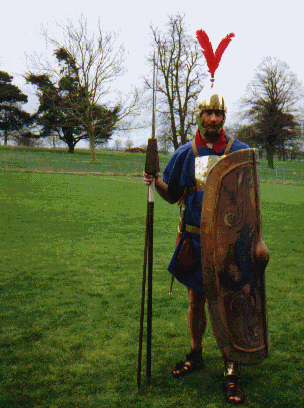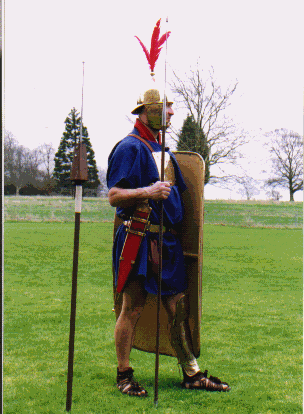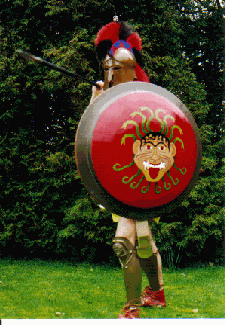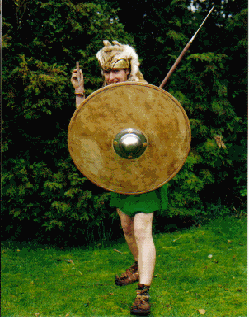| The Pre Imperial Roman Army |
 by J.Trede |
||
|
During the early centuries, the army of Rome was heavily influenced by the Etruscan Army, which in turn had learned and borrowed much from the Greek City States of Italy. The weapons and equipment were predominantly of Greek type and origin, and most battles were fought on foot, using the well tried and tested Greek 'phalanx'. |
|||
|
Early Days |
Friendly veles |
||
Recruitment was strictly based on citizenship and wealth. The assumption being that only a man with property to lose could be expected to defend it effectively, not to mention arming and equipping himself at his own expense. These citizens were in turn classified by their wealth into 5 classes of soldier. The wealthiest class formed the basis of the Legion, armed and equipped in the manner of a Greek hoplite. The remaining four classes made up the rest of the army in descending order of quality of arms and armour. Officers were selected from leading citizens, and enrolled into the Order of Knights, or Equites. Again at their own expense, but they were provided with a horse from the public purse. At this stage, the army was very much a defensive formation, called up as and when required
In about 390BC, a massive Celtic invasion of Italy resulted in the sack and burning of Rome. The Roman Army proved totally unable to defend its city, and was easily swept aside. After the Celts departed with their spoils, it was obvious that a serious reorganisation was essential to prevent any such disaster in the future.
After some experimentation and evolution the Legion emerged as a battle formation of three individual but flexible and interactive lines of soldiers. Individually these were known as the Hastati, the Principes, and the Triarii.. The Hastati of the front line were the pick of the army. Young men, well trained and well armed with sword, javelin and large shield or scutum. The Principes behind them were older men, selected for their experience and maturity. Possibly the best equipped, they were armed and armoured similarly to the Hastati..
 |
 |
||
|
Not
so friendly hastatus |
Not
so hasty hastatus |
During the 1st century BC, Roman influence was to expand rapidly, initially eastwards, and finally culminating in Caesar's Gallic conquests. Naturally, this new 'empire' would demand more and more troops to maintain it, and to enable further expansion. Ironically, fresh levies of troops became available as a result of the extremely bloody 'Social' wars between Rome and the disenchanted Italian tribes. Though Rome prevailed, the result was a general extension of Roman citizenship to the other tribes. These new citizens became instantly eligible to serve in the Legions, and not just as 'Allied' irregulars or auxiliaries.
However, there being no funds to establish these new legions, it fell upon wealthy citizens to provide the necessaries. This resulted in many 'private' armies, dependent on their founder and not on the Roman State. The Dictator Sulla, is reputed to have been the first to instigate an oath of loyalty to himself by his soldiers. Perhaps for this reason the 1st. century BC produced some remarkable military figures. Marius, Sulla, Pompey and Caesar, to name but the most famous. Their personal ambitions inevitably led to conflict, and the resulting civil wars occupied much of this century. But the empire continued to expand as one or other of them pursued their ambitions overseas.
During this turbulent period, further fundamental changes occurred in the army. Most of these have been attributed to the great soldier and statesman, Gaius Marius, although many of these may already have been gradually evolving. What is undisputed is that Marius opened up his legions to the very lowest citizen class. Without property and wealth, these slum dwellers had always been excluded from a military career. As civil and other wars took their toll, Marius recruited the 'sweepings of the gutters of Rome'. He armed and equipped them at his own expense, and provided them with a thorough military training. Though derided by most of Roman society, Marius nevertheless had set a precedent, and thus established the very first professional army. Totally loyal to himself, of course.The composition of the army also experienced another thorough revision during this period. The weapons and equipment of the legionary soldier were standardised, and the old distinctions between Hastati, Principes and Triarii were abolished. All legionary soldiers became the same, and were trained in a more flexible way of fighting. The main tactical formation became the Cohort, consisting of 6 Centuries of 80 men. There were 10 Cohorts to each Legion, giving a nominal strength of 4800 soldiers. The Legion became the focus of a soldiers' loyalty, under the sacred Eagle standard, also reputedly established by Marius.
After the battle of Actium, the victorious Octavian seized control of all Roman forces. He disbanded all surplus legions, retaining about 28, which he considered adequate for the defence of the Empire. Under the title of Augustus, he received a personal oath of loyalty from every unit of the Roman Army, thus ending a long period of strife and bloodshed.
Juris Trede, 1998

